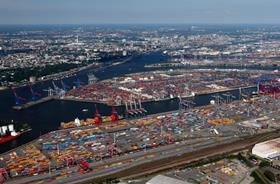
The Port of Hamburg Marketing Authority has announced that cargo throughput climbed by 11 per cent through the first nine months of the year, up to 99m tonnes, a result that enabled it to grab market share from some of the other major north European ports.
Container throughput came in at 6.8m TEUs (20ft-equivalent containers), yearly growth of 15.3 per cent, and compared favourably with container growth at Antwerp (up 3.1 per cent) and Rotterdam (up 7.7 per cent).
?'In recent months, Hamburg has succeeded in winning back market share to the order of one percentage point `that was` lost during the worldwide economic and financial crisis to the west ports of Antwerp and Rotterdam,' the Port Authority noted.
On the import side, the Authority put throughput at around 58m tonnes (up by 11.6 per cent), while exports via Hamburg stood at 41m tonnes, up by 9.2 per cent.
'I am especially pleased that with numerous feeder services and absolutely stunning volume growth, Hamburg has impressively underpinned its position as the leading feeder port in Northern Europe for the entire Baltic region,' said Claudia Roller, CEO of Port of Hamburg Marketing. 'For 2011 we can reckon on container throughput of around 9m TEU. We estimate that total seaborne cargo throughput in Hamburg for 2011 will reach around 133m tonnes. That would represent a gain of nearly 10 per cent.'
Even if the satisfactory advance in world trade may slow down somewhat towards the end of 2011 and moving forward into 2012, Roller sees next year as producing a moderate upward trend for the port.
'China, Asia, America and the Baltic countries, all of them particularly important foreign markets for Hamburg, do not currently lead us to expect that any collapses in seaborne foreign trade are in the offing,' she explained, adding that now is the time to continue expanding facilities at Hamburg.
'The very positive performance of the Port of Hamburg's throughput provides a clear signal for politicians, interest groups and the export trade that we should now be devoting all our energies, not to conjuring up crises, but to ensuring continued rapid expansion of infrastructure along with the water, rail and road traffic axes that are so vital for the port. We cannot afford to lose any time in the tough competition against ports further west and must systematically build-up and secure Hamburg's attractiveness both as a port and a logistics region for the future.'



